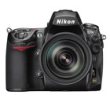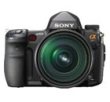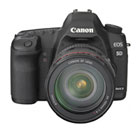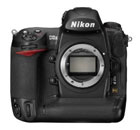Full Frame Digital SLR Cameras
In order to decide whether or not a full frame digital SLR camera is right for you, it helps to understand the impact of crop factor.
The vast majority of digital SLR cameras have sensors inside them that are physically smaller than a single frame of 35mm film (also called APS-C sensors).
The impact of this small-sized sensor is that when you use a lens on a digital SLR that was originally intended for a film camera, part of the image that the lens projects onto the sensor is cut off, or cropped: hence the term crop factor.
Crop factor goes by several other common names, including focal length multipler and equivalent zoom.
Since I have a completely separate page that talks all about crop factor, I won't go into any further detail here - if you're still fuzzy on the topic, go read that page first, then come right back here to find out more about full-frame digital SLR cameras.
What is a Full-Frame Digital SLR?
A full-frame digital SLR camera has a sensor that's about the same size as 35mm film.
This means that a full-frame camera has zero crop factor or a focal length multiplier of one. A 50mm lens on a full-frame SLR captures images just like a 50mm lens on a film SLR camera.
The Benefits of Full-Frame
The main issue associated with SLRs with smaller sensors is that wide-angle lenses don't quite the same view of the world when attached to one of these cameras.
Let's assume for a moment that we're using a lens on a cropped sensor digital SLR that has a 1.6x focal length multiplier.
Since a portion of the image projected onto the camera's sensor is getting cropped, that wide angle lens isn't so wide anymore. If the lens has a fixed focal length of 20mm (which is pretty wide in the world of film SLR cameras) it captures images more like a 32mm lens on the digital camera (not so wide anymore).
But on a full-frame SLR, that 20mm lens is STILL a 20mm lens.
Benefit #1: full-frame SLRs can use standard wide-angle lenses to capture dramatic landscapes and building interiors.
This means that full-frame digital SLRs really benefit photographers who take a lot of wide-angle pictures. If you're into portraits or wildlife photography, then getting the full view with wide angle lenses is less of a benefit.
For wildlife photography in particular (where you need to use extreme telephoto lenses to get close to your subjects) a full-frame camera is counter-productive, since it eliminates the artificial zoom that you get with cropped sensor SLRs.
But there's a second benefit of full-frame digital SLR cameras that make them appealing to any type of photographer:
Benefit #2: since a full-frame sensor is physically larger than other digital sensors, it can capture larger, higher quality images (especially in dim light).
Here's the difference in physical size between each one of the sensors (images are scaled correctly but not show actual size):
| COMPACT | APS-C | FULL-FRAME |
|---|---|---|
 |
 |
|
| 6.2x4.6mm | 22.2x14.8mm | 36x24mm |
Imagine that you have two 10 megapixel sensors: one is APS-C and the other is full-frame. Each 10 megapixel sensor is made up of 10 million individual light-gathering elements called photosites.
If you take a quick look at the table above that shows the relative sizes of the different sensors, you'll quickly realize that in order to cram the same number of photosites onto the APS-C sensor, each photosite must be physically smaller (otherwise they wouldn't all fit on the reduced surface area).
When photosites get smaller, two things happen:
- Each photosite is less capable of capturing extended dynamic range
- Each photosite produces more noise at high ISO settings
This means that a full-frame sensor with the same number of megapixels as an APS-C sensor should produce dramatically less noise at high ISO settings and should capture more detail in both shadows and highlights. Net result: better image quality.
This last statement would hold true, except for the fact that full-frame camera makers are not content to stick to the megapixel status quo.
Instead, they pack their full-frame sensors with even MORE megapixels — reducing the size of each photosite and effectively nullifying the benefit of a larger photosite.
However, there are two benefits to the additional megapixels you get with a full-frame sensor:
- You can print your images as significantly larger sizes with no loss of detail
- You can crop out huge portions of the image and still print at very large sizes
Take the 24.6 megapixel Sony Alpha A900 for an example. At full size, you can print out images measuring a whopping 20 x 30 inches (movie poster size), and even if you crop out a full 50% of the photo, you can still make great prints at 12 x 16 inches.
So — even if you're not getting photosites that are physically larger than those available on cameras with smaller sensors, you're getting a LOT more photosites packed onto the sensor which has its own benefits.
Current Full-Frame Digital SLR Cameras
Make no mistake — since full-frame cameras include larger sensors than their regular crop-frame counterparts, they cost more...a LOT more.
The feature sets of these cameras also make them appealing to semi-professional and professional photographers, which also raises the price.
Since full-frame cameras do have the potential to capture higher-quality images, you can expect to see more of these in the future with some - hopefully - priced for the consumer market.
Cameras are listed in chronological order based on release date.
| CAMERA | RELEASED | MP | DESCRIPTION | PRICE |
|---|---|---|---|---|
|
Canon 1Ds MK III
|
November 2007 | 21.1 | Squarely aimed at the pro photographer market, the 1Ds Mark III has it all: 5 photos per second, 45-point autofocus, low noise at high ISO, weather-resistant seals and gaskets, dust control and a 3 inch live view LCD. | $6,090 |
|
Nikon D3
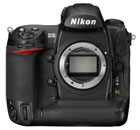 |
November 2007 | 12.1 | The D3 is really geared for professional use, and is the predecessor to the smaller D700. It has virtually no noise at high ISO settings, can blaze through 9 photos in one second, and has a relatively unique horizon level indicator. | $3,500 |
|
Nikon D700
|
July 2008 | 12.1 | The D700 has a huge ISO range from 100 to 25600, and pairs this with a 51-point autofocus system, 0.12 second start-up time and a clear, bright 3 inch live view LCD.. | $2,700 |
|
Sony Alpha A900
|
October 2008 | 24.6 | Packing the highest megapixel count (barely), the Sony A900 is also the only full-frame camera with built-in image stabilization. Also included is a 5 photo-per-second burst mode and multiple levels of dynamic range control. Low price full-frame DSLR | $2,500 |
|
Canon 5D MK II
|
December 2008 | 21.1 | The 5D Mark II is the second digital SLR to include a movie capture mode after the Nikon D90 (High Definition 1080), and has a massive ISO range: from 50 to 25600. Low price full-frame DSLR | $2,500 |
|
Nikon D3x
|
December 2008 | 24.5 | The D3x combines all the features of the D3 with a high resolution sensor. This is a camera designed for professional use and its color, clarity and low ISO performance are exceptional - what you'd expect for a camera with this price tag. | $7,999 |

|

